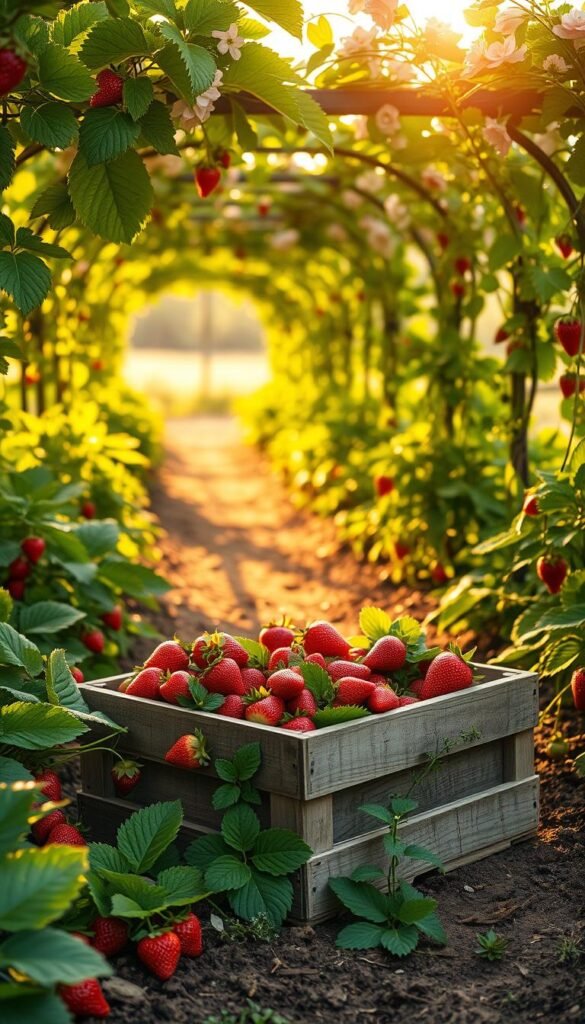More home growers are embracing natural methods to cultivate juicy, flavorful berries right in their backyards. Whether you’re new to growing strawberries at home or refining your skills, adopting earth-friendly practices creates healthier plants and tastier results.
You’ll quickly see why nutrient-rich soil matters most for vibrant growth. By focusing on natural amendments like compost and proper sunlight exposure, your plants develop stronger roots and sweeter fruit. Many enthusiasts report their homegrown harvests outshine store-bought options in both flavor and texture.
Discover how simple adjustments to your routine can prevent common issues like pests or weak yields. Techniques such as strategic mulching and pH-balanced beds ensure your efforts pay off with minimal frustration. Even better, these methods protect local ecosystems while producing food you’ll feel good about sharing.
Imagine plucking sun-warmed berries straight from your own patch – no synthetic chemicals required. With the right foundation, you’ll enjoy abundant crops season after season. Let’s explore how to create the ideal environment for your plants to thrive naturally.
Getting Started with Organic Strawberry Gardening
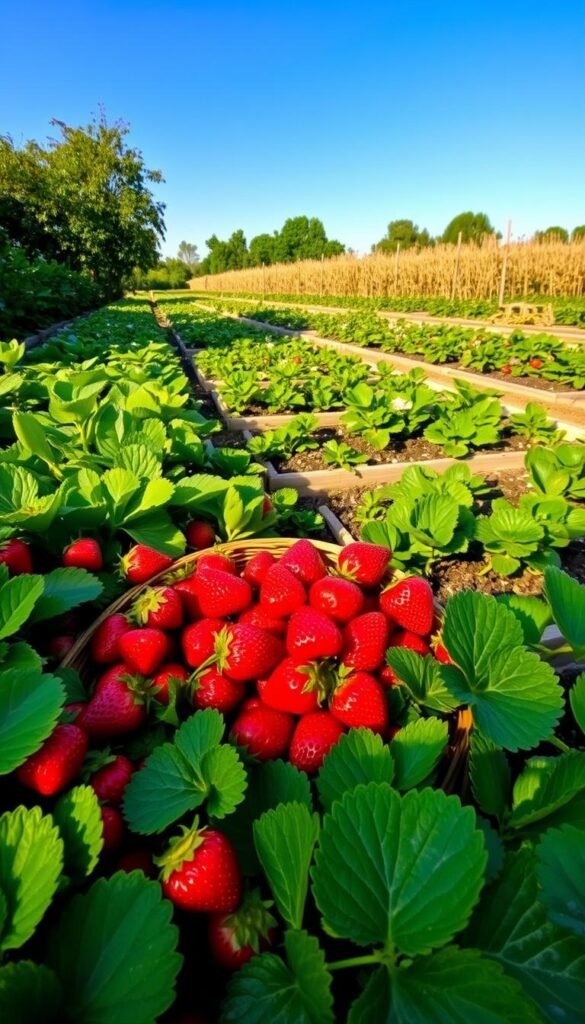
Choosing natural growing techniques lets you enjoy sweeter fruit while protecting local ecosystems. Unlike conventional approaches that depend on synthetic additives, organic cultivation works with nature rather than against it.
Why Natural Methods Matter
Traditional growing often uses chemical fertilizers and herbicides like Roundup®. Organic practices replace these with compost, natural pest deterrents, and soil-building techniques. This organic gardening basics approach creates resilient plants that resist diseases naturally.
| Aspect | Organic | Conventional |
|---|---|---|
| Fertilizers | Compost, manure | Synthetic NPK blends |
| Soil Health | Improves yearly | Depletes nutrients |
| Pest Control | Beneficial insects | Chemical sprays |
| Fruit Safety | No residues | Trace chemicals |
| Longevity | 5+ seasons | 3-4 seasons |
Rewards Worth the Effort
While organic growing strawberries demands more attention initially, the payoff comes in vibrant plants and richer flavors. You’ll attract pollinators like bees while keeping harmful chemicals away from kids and pets.
Three key advantages stand out:
- Safer snacks straight from the vine
- Deeper root systems from healthy soil
- Continuous improvement in plant vitality
Your efforts create a mini-ecosystem where earthworms aerate beds and ladybugs handle aphids. This balance means fewer interventions over time – nature does the heavy lifting.
Choosing the Right Strawberry Varieties
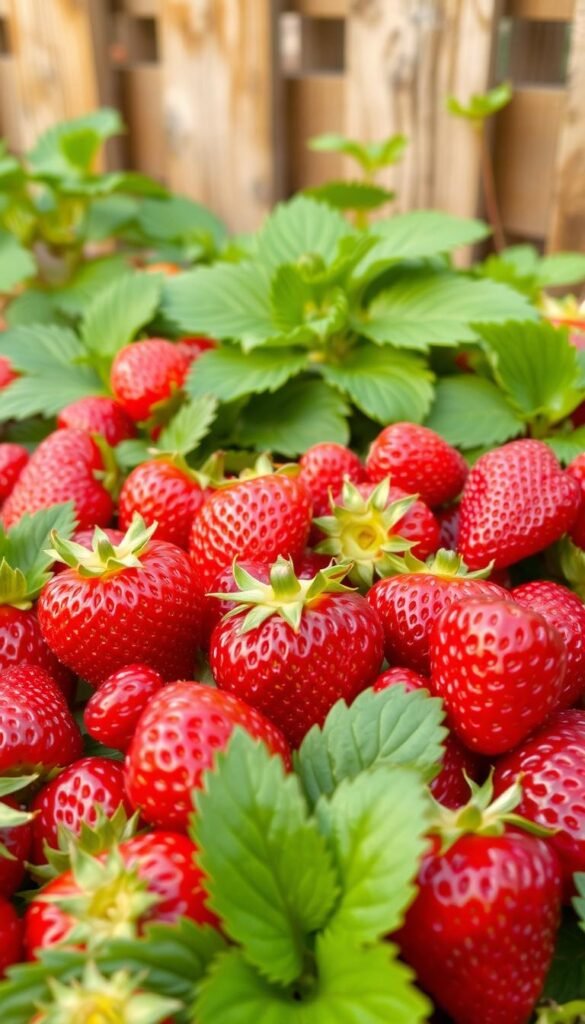
Your berry patch’s success begins with matching plant types to your goals and environment. Three main categories offer distinct advantages depending on whether you prioritize harvest size, extended availability, or casual snacking.
June-bearing, Everbearing, and Day-neutral Explained
June-bearing varieties deliver a spectacular 2-3 week showstopper crop. These heavy producers yield large, juicy fruits ideal for preserves or freezing bulk quantities. Perfect for those who love canning or sharing with neighbors.
Everbearing types surprise you with twin harvests – early summer’s first flush and a fall encore. While yields are smaller, you’ll enjoy fresh berries over more weeks. Great for steady lunchbox additions or patio containers.
Day-neutral plants keep things interesting all season. You’ll find ripe treasures nearly every day from summer through frost. Though individual berries stay petite, their continuous production suits grazers who prefer frequent handfuls.
Factors to Consider When Selecting a Variety
Your local climate plays matchmaker. Some varieties thrive in humid zones while others resist root diseases common in wet soils. Check your USDA hardiness zone against plant tags for best results.
- Space availability: Compact day-neutral types fit small yards
- Usage plans: Baking needs sturdy berries; fresh eating favors sweetness
- Maintenance style: June-bearers demand intense care during peak season
Disease-resistant cultivars prove invaluable for organic growers. They naturally fend off common fungal threats, reducing your intervention needs. Remember: The right choice balances practicality with personal berry dreams.
Selecting the Optimal Garden Location & Layout
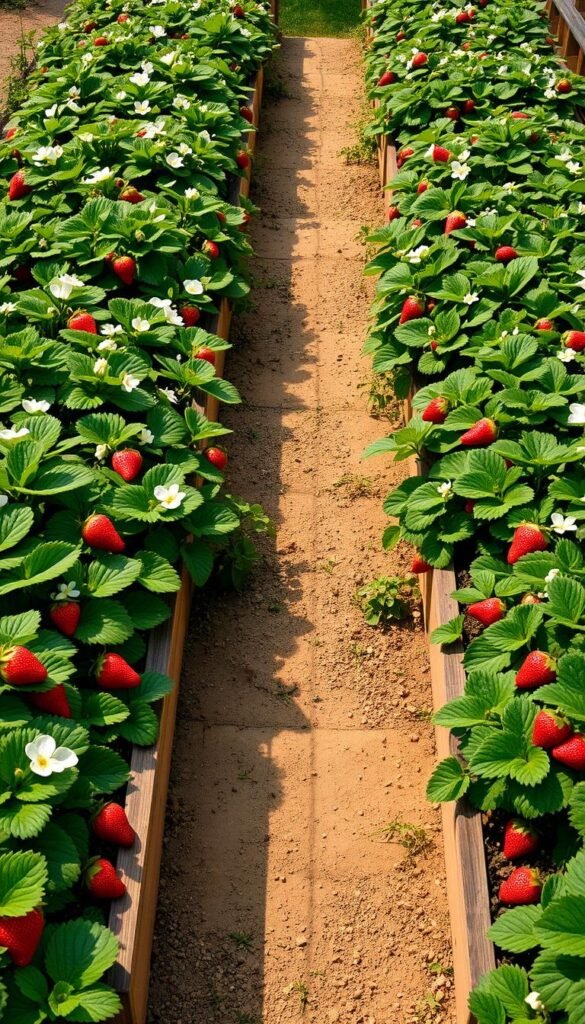
Finding the perfect spot for your berry patch can feel like matchmaking with nature. While these resilient growers adapt to various conditions, strategic placement boosts yields and minimizes headaches. Let’s break down the non-negotiables for prime real estate.
Sunlight, Drainage, and Soil Essentials
Your plants crave sunshine like kids love ice cream – 6-8 daily hours is the golden rule. Morning light dries dew quickly, reducing fungal risks. Watch shadows from buildings or trees throughout the day before committing to a site.
| Factor | Ideal Condition | Quick Fixes |
|---|---|---|
| Drainage | 1″ per hour absorption | Raised beds or slopes |
| Soil pH | 5.5-6.8 | Add pine needles or wood ash |
| Airflow | 3-5 mph breeze | Prune nearby shrubs |
| Spacing | 12″ in ground | Staggered rows |
Test drainage by digging a 12″ hole and filling it with water. If it takes over 4 hours to drain, consider raised beds. Space plants like you’re social distancing – crowded roots compete for nutrients.
Keep your patch accessible for daily checkups. A handy location near your tool shed or kitchen door makes harvesting irresistible. Remember: Happy plants need room to breathe and easy access to your care!
Organic Soil Preparation Techniques
Transforming ordinary dirt into thriving earth starts with smart soil choices. You’ll build a foundation where roots spread freely and nutrients flow steadily. Begin by testing your dirt’s pH and organic content – most local extension offices offer affordable kits.
Amending Native Soil with Organic Compost
Mix 2-4 inches of mature compost into your topsoil. This creates air pockets while locking in moisture. For raised beds, layer it like a lasagna – compost on top, native soil beneath. Pro tip: Let the mixture settle for 10 days before planting.
Using Natural Fertilizers and Nutrient Sources
Balance nitrogen sources like feather meal (15% N) with phosphorus-rich bone meal. Fish emulsion works wonders for quick boosts. Avoid fresh manure – it burns roots and delays fruiting. Instead, try no-dig gardening methods that preserve soil structure while feeding plants.
Watch for these signs of success:
- Earthworms appear within 3 weeks
- Water absorbs quickly without pooling
- Seedlings establish faster than expected
Remember: Over-fertilizing creates leafy giants with few berries. Stick to slow-release options like alfalfa pellets. Your patience pays off in sweeter harvests and stronger plants year after year.
Watering and Nutrient Management for Healthy Strawberry Plants
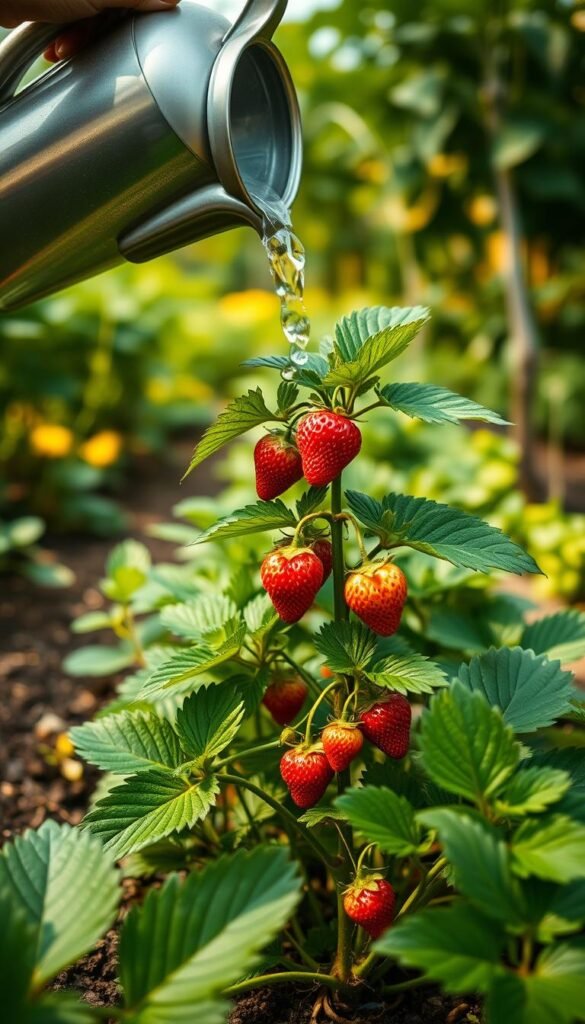
Keeping your plants hydrated and well-fed makes all the difference between sparse pickings and overflowing baskets. The right balance prevents stress while maximizing flavor and yield. Let’s break down how to quench thirst and feed roots effectively.
Efficient Watering Practices for Organic Gardens
Consistency is key. Aim for 1-1.5 inches of moisture weekly, including rain. Use a rain gauge to track nature’s contributions. Pro tip: Water early morning to reduce evaporation and fungal risks.
- Target soil around roots – avoid wetting leaves
- Deep soak beds 2-3 times weekly instead of daily sprinkles
- Check soil moisture by pressing a finger 2″ deep
Drip systems or soaker hoses work best. They deliver hydration directly where needed while conserving resources. Sandy soils may need more frequent sessions than clay-based earth.
Maintaining Balanced Nitrogen Levels
Spring brings explosive growth that drains soil nutrients. Plants crave nitrogen most during flowering and runner development. But overdo it, and you’ll get leafy jungles with few berries.
| Organic Source | Nitrogen % | Best Used |
|---|---|---|
| Alfalfa meal | 3 | Early growth stages |
| Fish emulsion | 5 | Pre-bloom boost |
| Blood meal | 12 | Severe deficiencies |
Apply amendments sparingly – a light sprinkle every 4-6 weeks suffices. Yellowing lower leaves signal shortages, while dark green foliage hints at excess. Always water thoroughly after feeding to prevent root burn.
Weed Management Strategies in Your Organic Garden
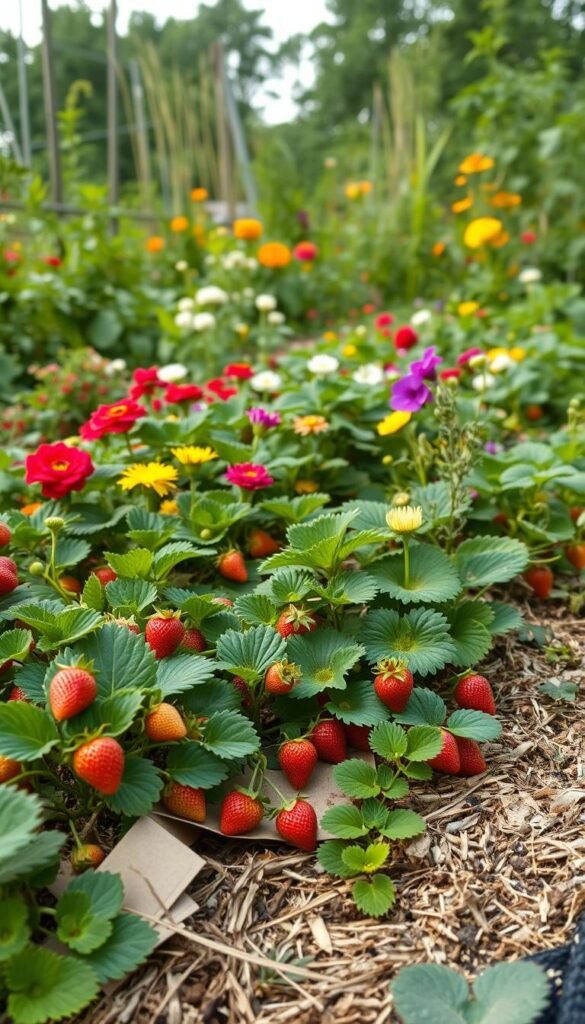
Maintaining a weed-free patch requires smart tactics that work with nature’s rhythms. While it demands attention, proper techniques keep invaders at bay without harsh chemicals. Let’s explore practical methods to protect your precious crops.
Hand-pulling and Shallow Cultivation Methods
Early intervention makes all the difference. Check beds every 3-4 days during peak growth periods. Target weeds after light rain or watering when roots release easily from damp soil.
| Method | Best For | Pro Tips |
|---|---|---|
| Hand-pulling | Young weeds near plants | Twist gently to remove entire root |
| Hoeing | Row middles | Work when soil surface is dry |
| Mulching | Prevention | Use 3″ straw layer |
| Corn gluten | Pre-emergent | Apply early spring |
Combine approaches for maximum impact. A weekly 10-minute session beats marathon weeding sprees. Remember: One missed dandelion can produce 2,000 seeds!
Organic herbicides like GreenMatch Ex help manage tough cases but shouldn’t replace manual care. Always spot-test new products on a few leaves first. Your plants will thank you with stronger growth and better yields.
Stay vigilant against these common troublemakers:
- Crabgrass – spreads quickly in thin mulch
- Chickweed – thrives in moist conditions
- Bindweed – requires persistent removal
With consistent effort, you’ll spend less time battling weeds and more enjoying sweet rewards. Healthy soil and proper spacing naturally reduce unwanted guests over time.
Effective Natural Pest and Disease Control
Balancing your garden’s ecosystem can prevent most pest problems before they arise. By combining smart prevention with gentle interventions, you’ll protect your crops while keeping the environment safe. Let’s explore how to maintain plant health without compromising nature’s delicate rhythms.
Preventing Disease with Mulching and Sanitation
Start with disease-resistant plants and well-draining soil to avoid fungal issues. Spread 3 inches of straw mulch around stems – this stops soil from splashing onto leaves during rains. Remove fallen leaves and spent blooms weekly to disrupt pest breeding grounds. Pro tip: Space plants properly for airflow, reducing moisture-loving diseases by up to 40%.
Organic Solutions for Pest Management
Diatomaceous earth works wonders against crawling insects when dusted lightly under leaves. Introduce ladybugs to handle aphids naturally – they’ll feast on 50+ pests daily. For stubborn infestations, biopesticides like Serenade® target harmful microbes without harming pollinators. Learn more about avoiding common beginner gardening that often lead to pest outbreaks.
Regular monitoring helps catch issues early. Check leaf undersides weekly and remove damaged fruit promptly. With these strategies, your plants stay vigorous while producing bountiful, chemical-free harvests season after season.

